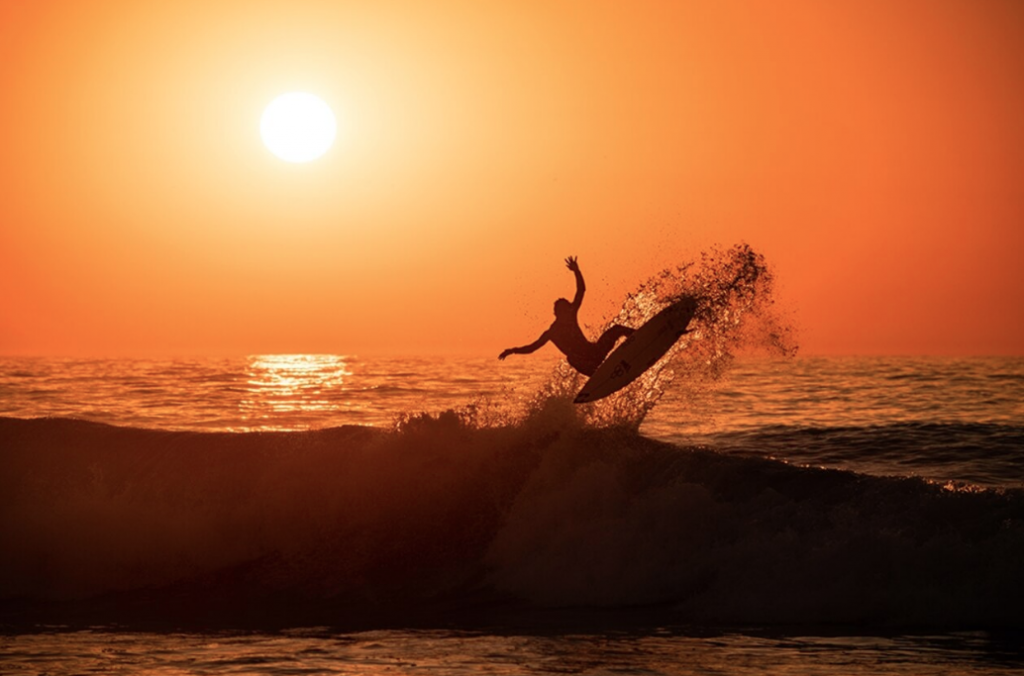
Ericeira has established itself as the ultimate playground for European surf culture. But tear yourself away from the beaches and adventures beckon inland, too, all less than an hour’s drive from Lisbon.
Read the article on nationalgeographic.com
I have never until now taken time to consider the creation of a wave. To fathom the climatic and gravitational forces propelling salt water across sunken topographies so that it swells, rises, arcs and finally dissipates in powerful fits of foam. And this lack of prior attention feels like a critical failure now I’m standing — wetsuit plastered on, awkwardly gripping a sturdy beginners’ softboard — on one of Europe’s most famous surfing beaches.
Instructor Francisco Romeiras from Ericeira Surf Clube points at the waves raking across the mouth of Ribeira d’Ilhas, a sensational amphitheatre of a beach with sheer, golden cliffs cupping the Atlantic. “It’s a long point break, breaking on the right,” he says, drawing on a lexicon unique to boardriders. “This wave, its consistency, the way it delivers in all tides, it’s what drew the first surfers to Ericeira back in the early 1970s. Ready to give it a try?”
I’m relieved I’m not directed towards the distant figures carving shapes out in the deep water. Instead, I spend an hour with Francisco finding my feet nearer the shore. “Don’t overthink it,” he reminds me as a small wave catches my board and I discover I’m travelling with the ocean at what feels like break-neck speed. “Knees bent! Eyes on the beach!” he shouts as, for the first time, I successfully launch from belly to feet, before eventually toppling, starfish-limbed, into the shallows.
When we pad out of the surf an hour later, Francisco draws my attention to a promontory marked by a silver statue of a surfer. ‘The Guardian’ was created by José Queiroz in 2017, as a clarion call for environmental protection and preservation. It’s become the unofficial symbol of Ericeira as the town continues to settle into its status as a World Surfing Reserve. The designation, awarded in 2011 by Save the Waves Coalition, celebrates the culture, economy and environment of outstanding surf locations and Ericeira was the second place in the world after Malibu, California, to be recognised. “It really put us on the map,” Francisco says. In May 2023, a 12th location was enshrined that delighted British surfers: North Devon.
As we store away our boards, I’m introduced to Ulisses Reis, a veteran of the scene. “I was one of the first people teaching here. There was just a basic surf camp on the beach, a place for hippies to hang out,” he tells me, momentarily lost in his memories. “But it was demolished.” Today, there’s a sleek boardwalk with wood-slatted surf shacks, showers and a cafe. The complex is home to Ulisses’ surf school, Blue Ocean, from where his sons now give lessons. It’s also one of over 50 in Ericeira. “I worry about the commercialisation of surfing here, how fast things are changing. This is all great,” he says, gesturing around, “it’s my whole life now. But personally I preferred it before.”
If there’s tension in the community over the rising tide of travellers, it’s impossible to feel it as I explore the white-washed lanes of the historic centre later that day. Surf shops, upmarket clothing boutiques and cafes serving poke bowls fit alongside timewarp tavernas and bakeries selling ouriços (local almond cakes). I discover houses inlaid with antique tiles petitioning saints against maritime disasters and modern street art filled with surfing motifs. The sport may be a relatively new phenomenon in this traditional fishing community founded in 1229, but it’s already woven into the very fabric — and driving the local economy.
“It’s hard being a fisherman. The tides, the conditions. The older men are glad their sons can work in surf tourism for a good life and still live off the sea,” says Ana Vaz, from the region’s tourism bureau, the next day. We’re touring Ericeira’s interpretation centre, just off the main square.
Inside, an interactive model of the 2.5-mile coastline explains its seven distinct wave formations. Along with Ribeira d’Ilhas, there’s Pedra Branca and Reef, both found off Empa Beach; Crazy Left, Coxos and Cave, near Dois Irmãos Bay; and São Lourenço, a fast wave rising off a rocky plateau some 300 metres out from the beach. I finally begin to understand the geographical factors at play in creating conditions for surfing — and get a sense, too, of the culture and marine ecosystem locals are keen to preserve.
“Ericeira is no stranger to visitors. It was founded by seafarers, and its mineral-rich waters were discovered by travellers centuries ago, even before Vila Galé hotel was built,” Ana says, referencing the palatial local icon, built in 1955. Since the start of the pandemic, record numbers of digital nomads have also made Ericeira their temporary home. “The challenge is balancing the needs of new visitors with those of the residents, and encouraging travellers to explore beyond the World Surfing Reserve. There’s so much to do if you look inland, too.”
Taking this as a challenge, I plot a path into the department of Mafra. I pass rolling green pastures peppered with lemon farms; small stone villages like José Franco, famed for ceramics; and family-run vineyards such as Quinta de Sant’Ana. At the heart of the region is the sumptuous Palace of Mafra. Built by King João V in the 18th century, the baroque edifice is buttressed by a basilica, convent and the 2,000-acre walled Tapada hunting grounds.
It’s in the hilltop honeypot of Sintra, to the south, that I try my hand at another sport. The flowering town, with its old fortresses and crooked alleyways, needs little introduction — 19th-century poet Lord Byron is among the many British travellers to have fallen for its charms, describing it as a ‘glorious Eden’. But few visitors would guess that the granite mountain slabs stacked beneath the western ramparts of the 8th-century Moorish Castle offer some of the best rock climbing in the country.
“You have to trust. In your feet, your equipment, your mind,” says Luis Batista, a climbing instructor from adventure sports company Desnivel, as he tightens my harness. “It’ll be worth it for the view.” We crane our necks at the 150ft-high mass of stone rising from the forested path. This is Penedo da Amizade, the largest cliff face in Sintra, with a purported 72 different near-vertical paths of ascent. Luis gets me started on an easy grade III, which he first models nimbly, demonstrating how to grip onto sheer surfaces and leverage body weight to climb. As with surfing, my first attempts aren’t steady or dignified, and fear mixes queasily with resolve. But on my third ascent, something clicks. I trust my feet. I reach higher. I find purchase where none could be found before, and I make it to the top.
The western coast of Portugal is laid out below me like a map, land unfurling towards a binary expanse of ocean and sky. The past week has seen me exploring both of these unlikely domains, learning new skills — and gaining new perspectives — alongside experts who’ve made riding waves and scaling lofty heights the focus of their lives. I take a moment to drink in the scene: the tiny, turreted pleasure palaces of Sintra dotted below and the gulls gliding by on balmy thermals. But only for a moment. Luis is calling out and it’s time to come back down to earth.
How to do it
TAP offers flights to Lisbon from Gatwick, Heathrow, Manchester and Dublin year round. Sea view rooms at Vila Galé Ericeira hotel start from €120 (£103), B&B.
Published in the September 2023 issue of National Geographic Traveller (UK).

